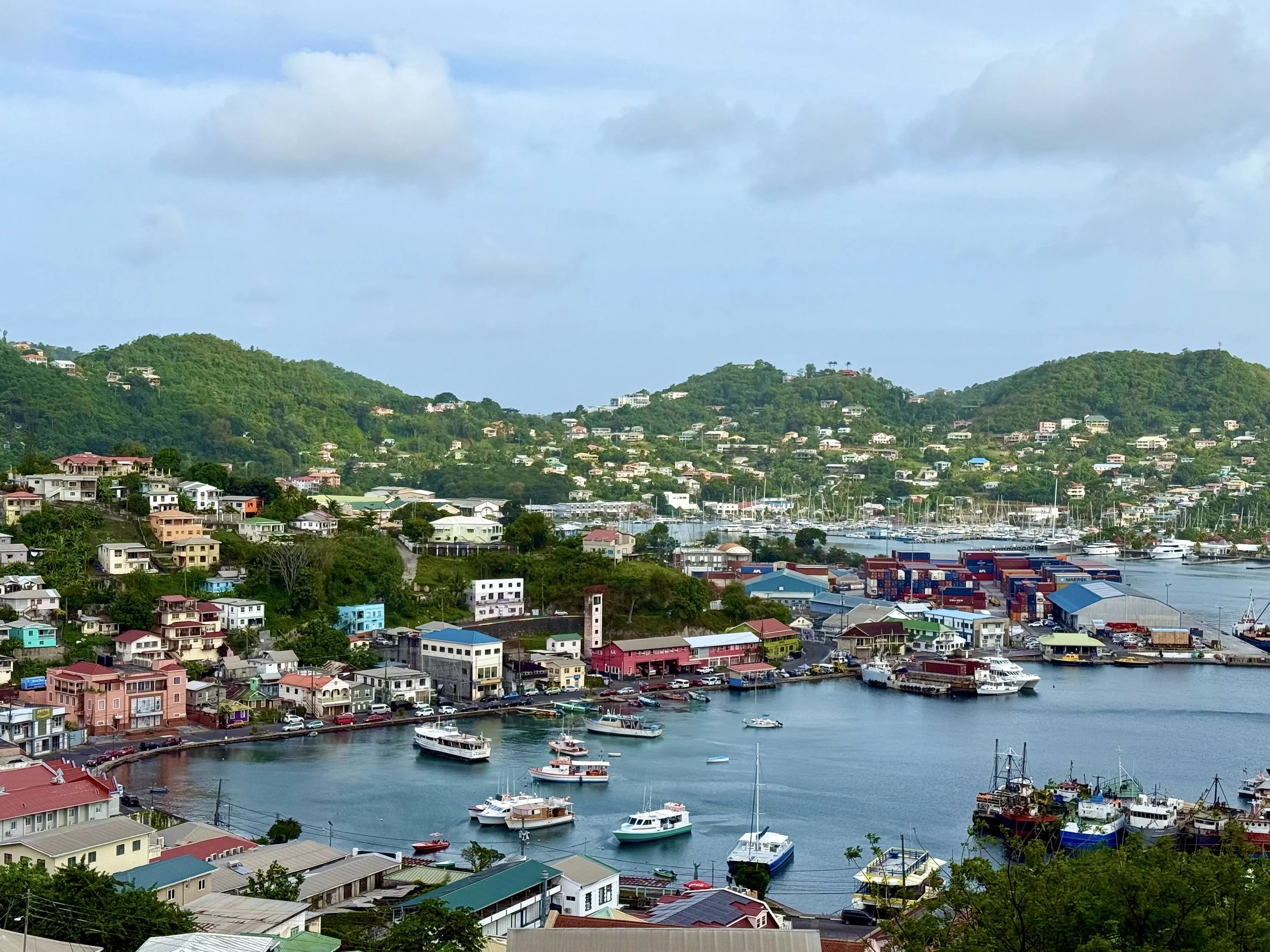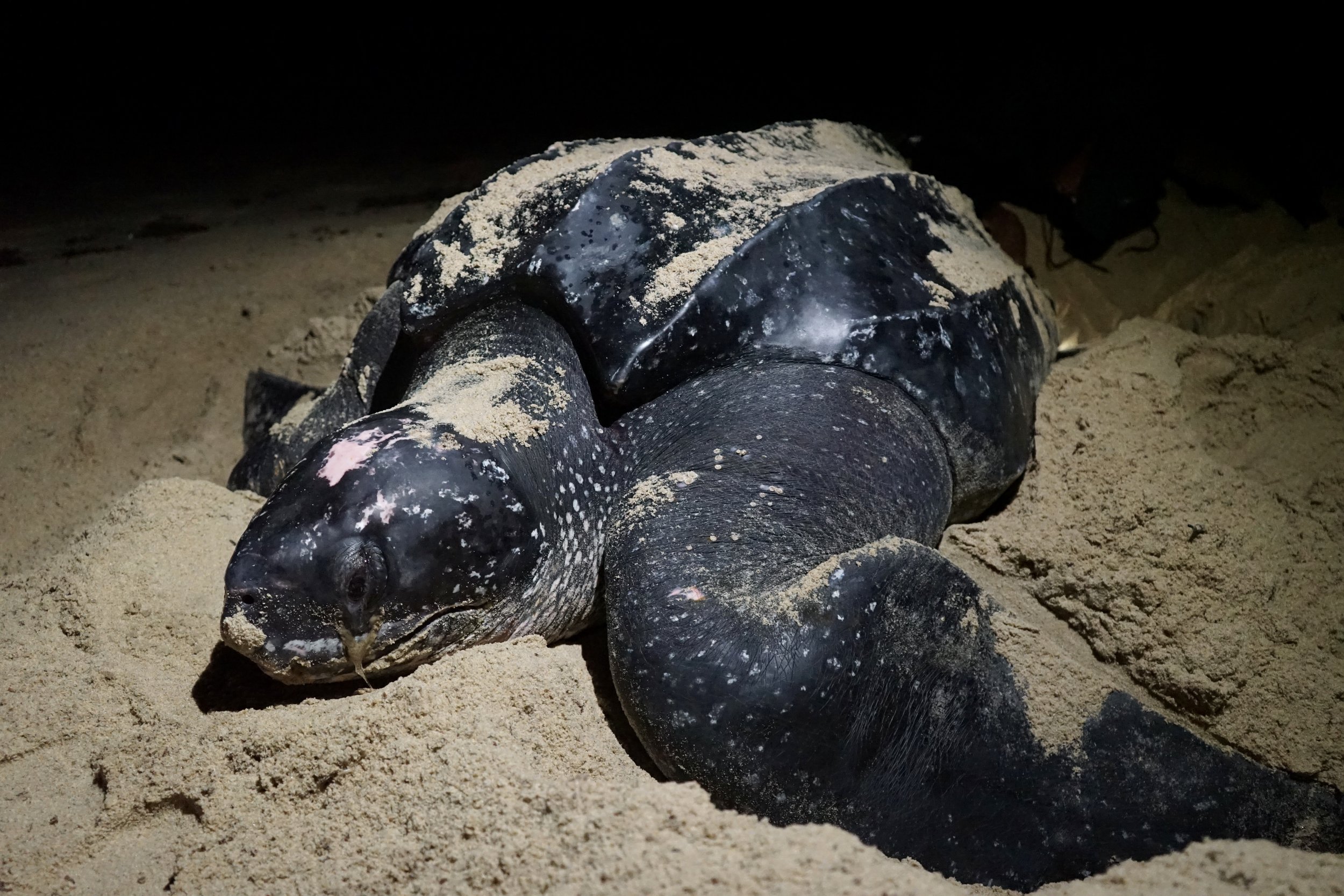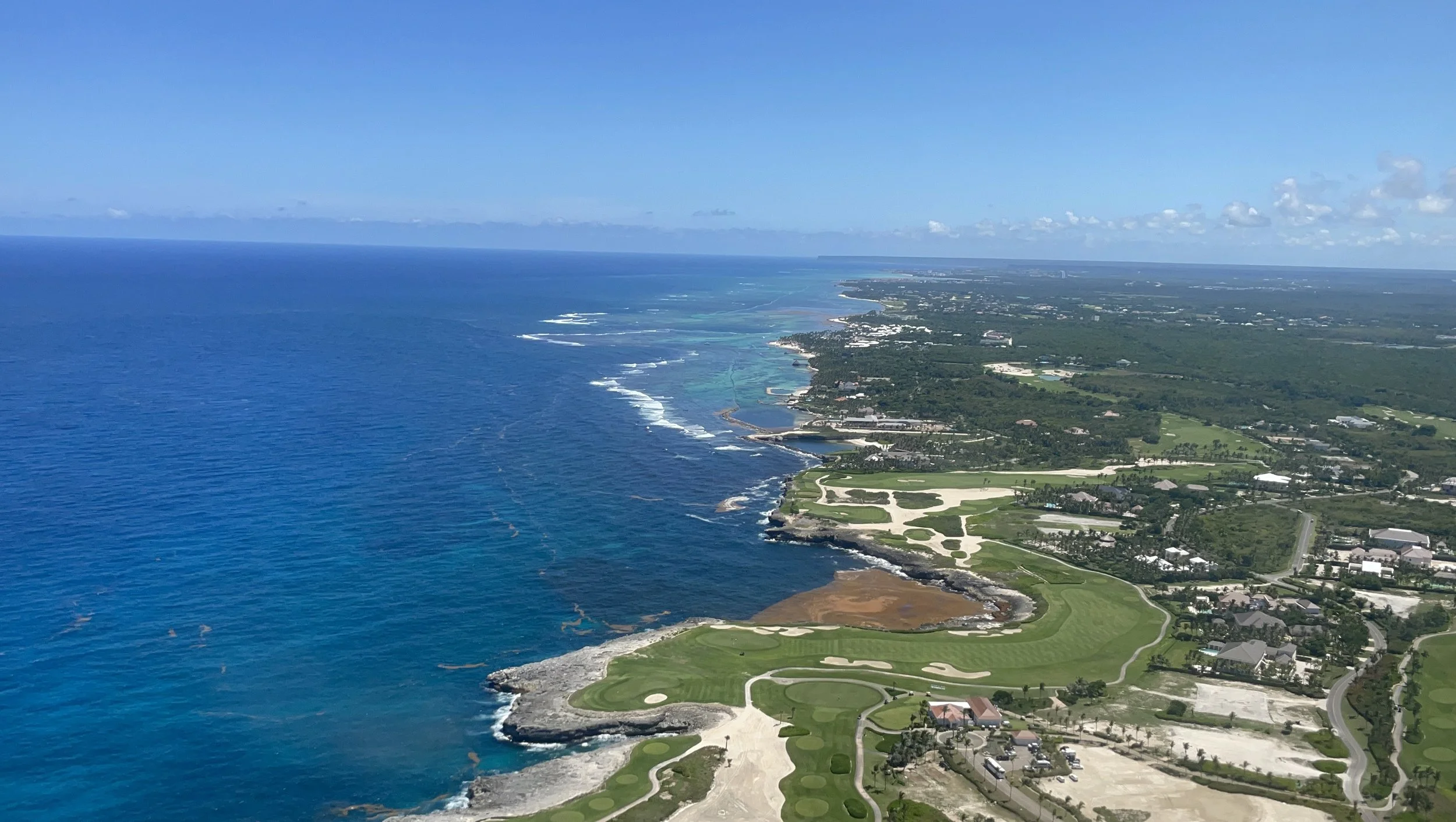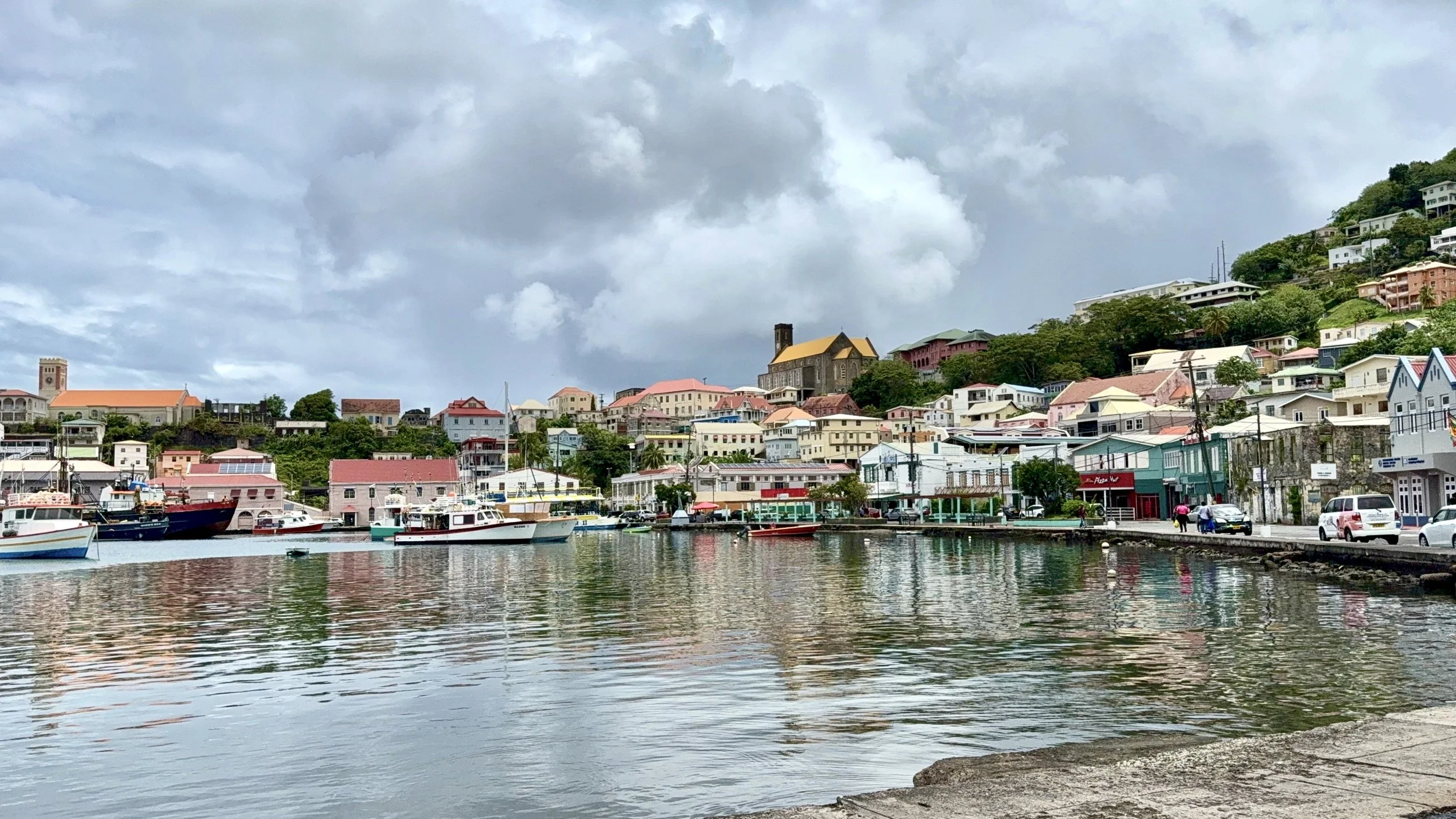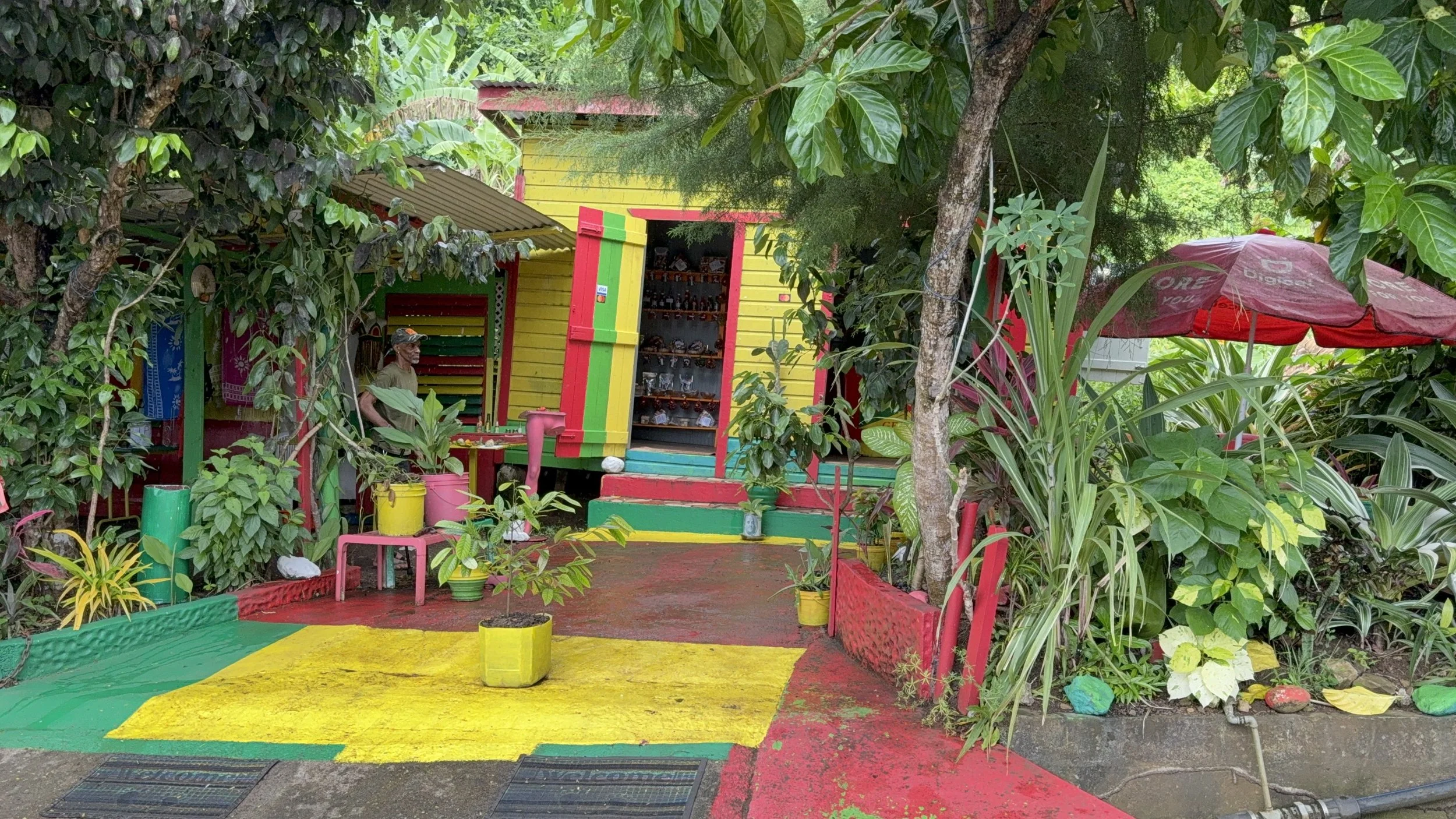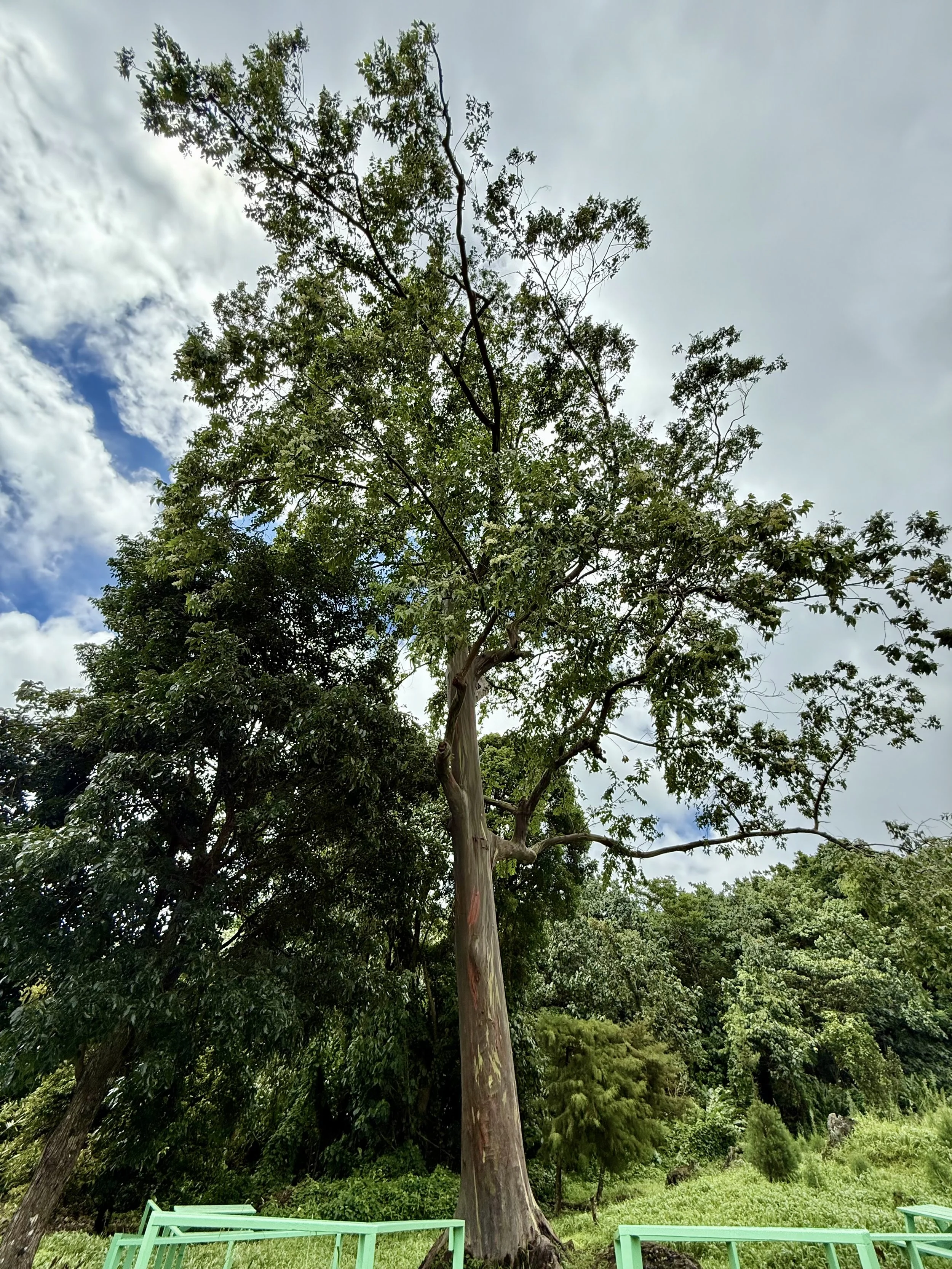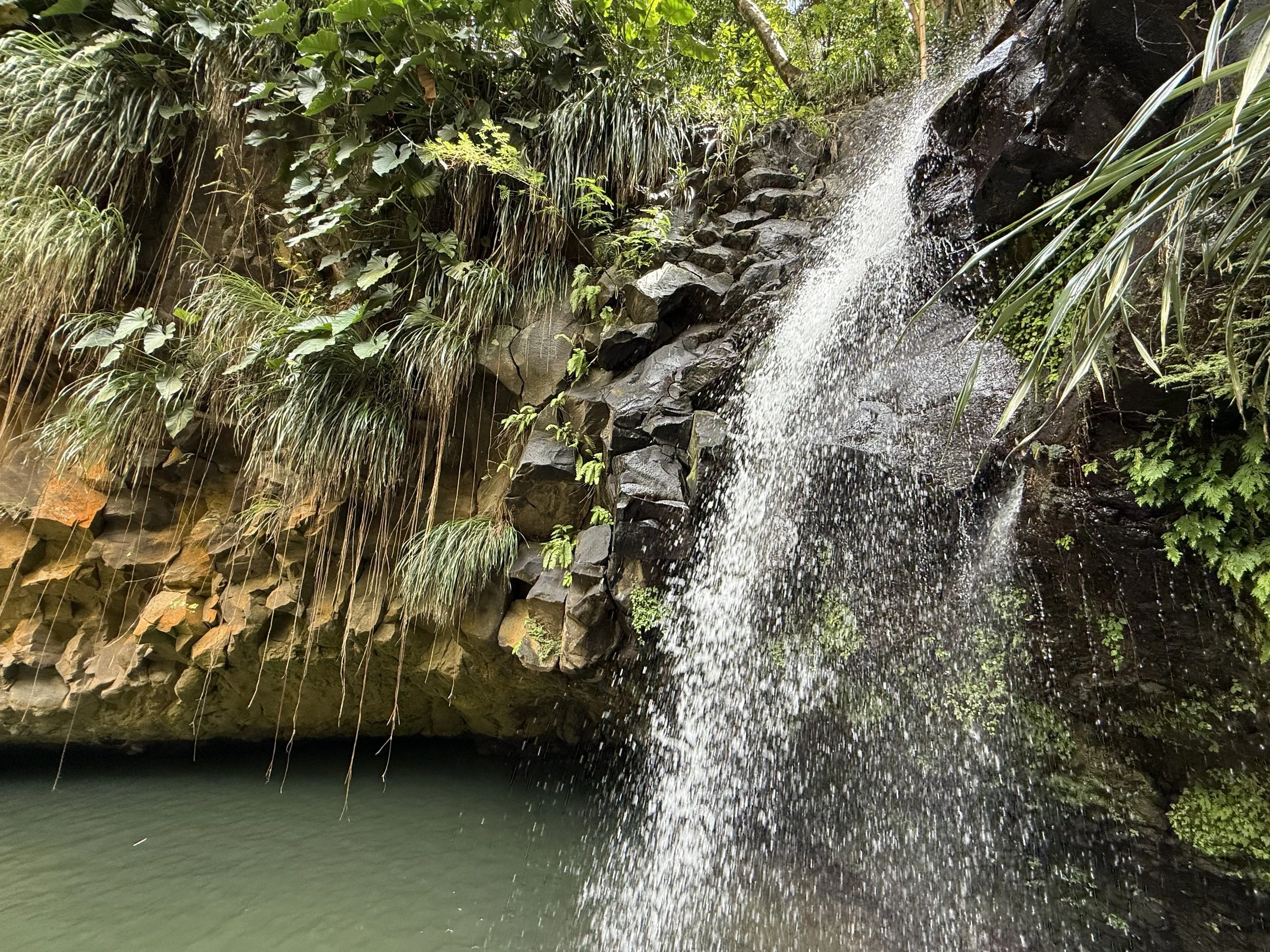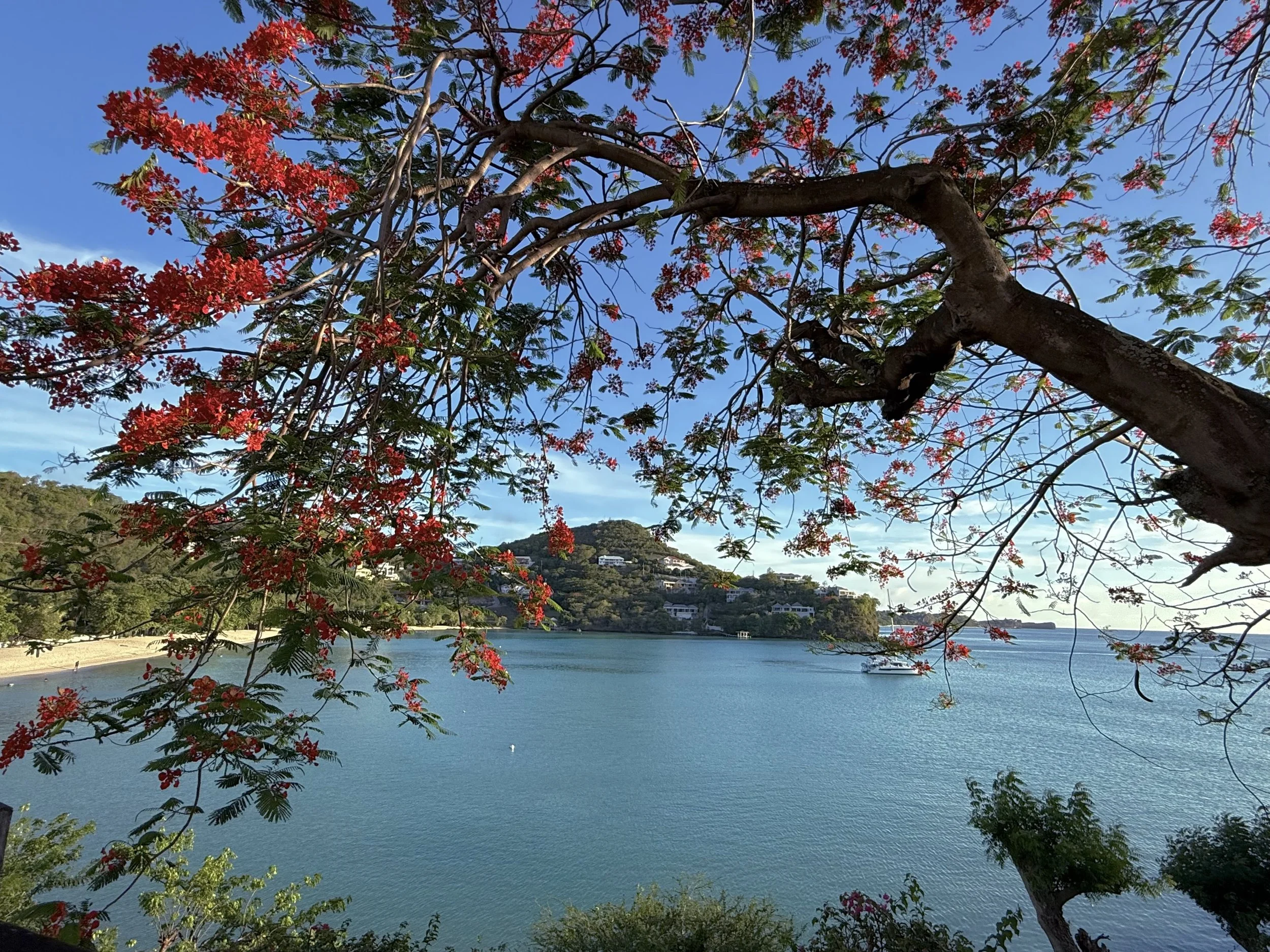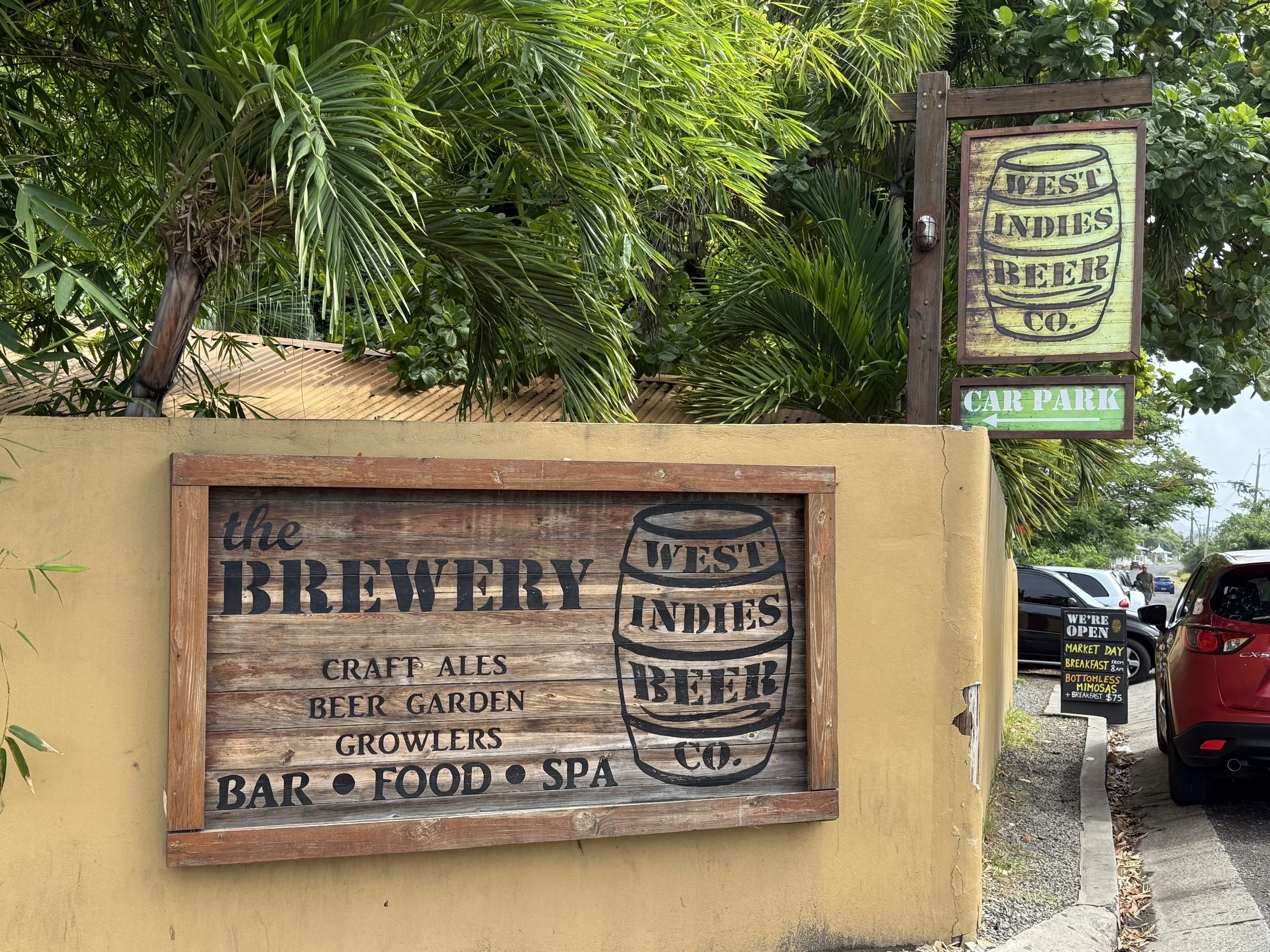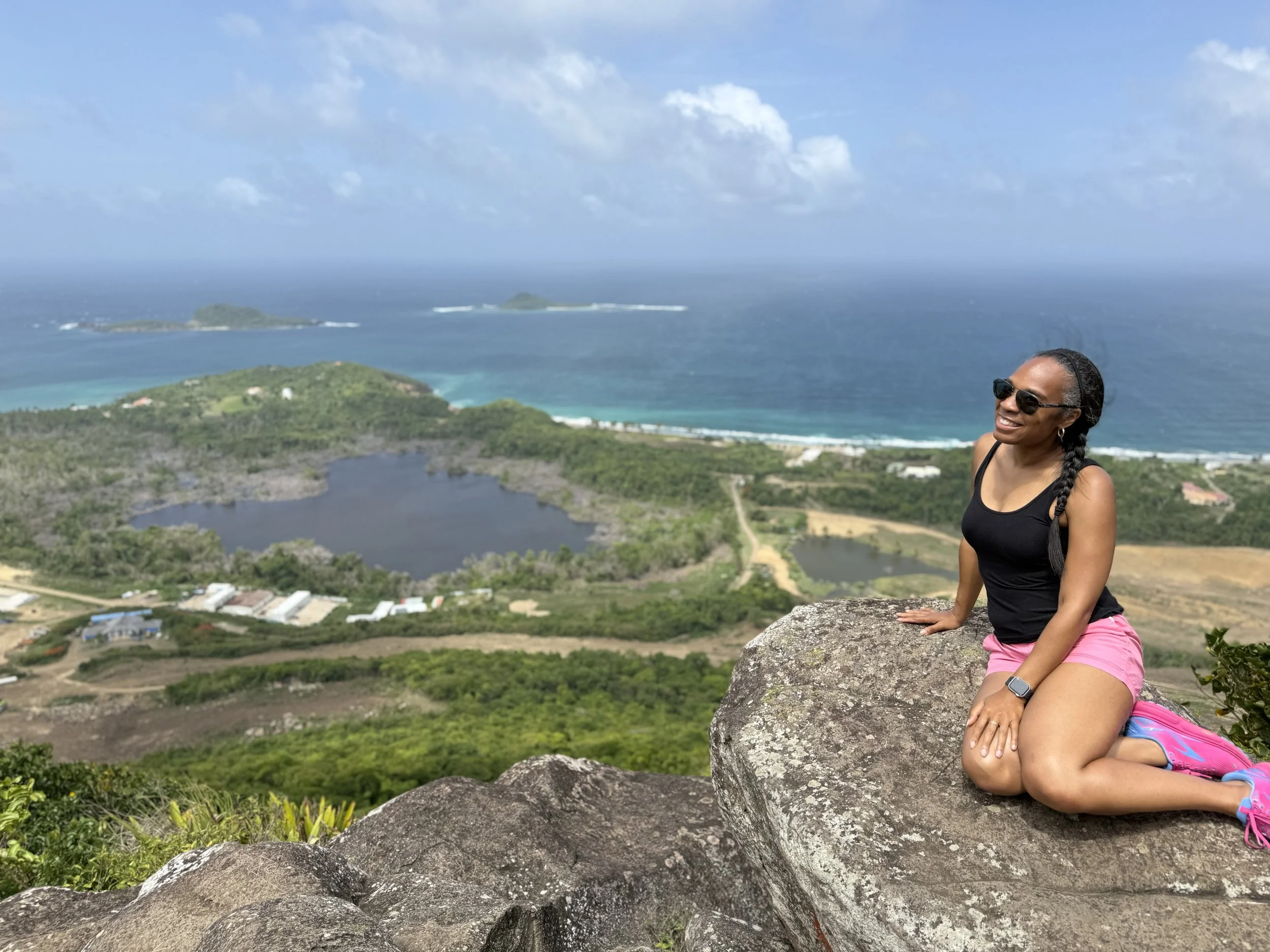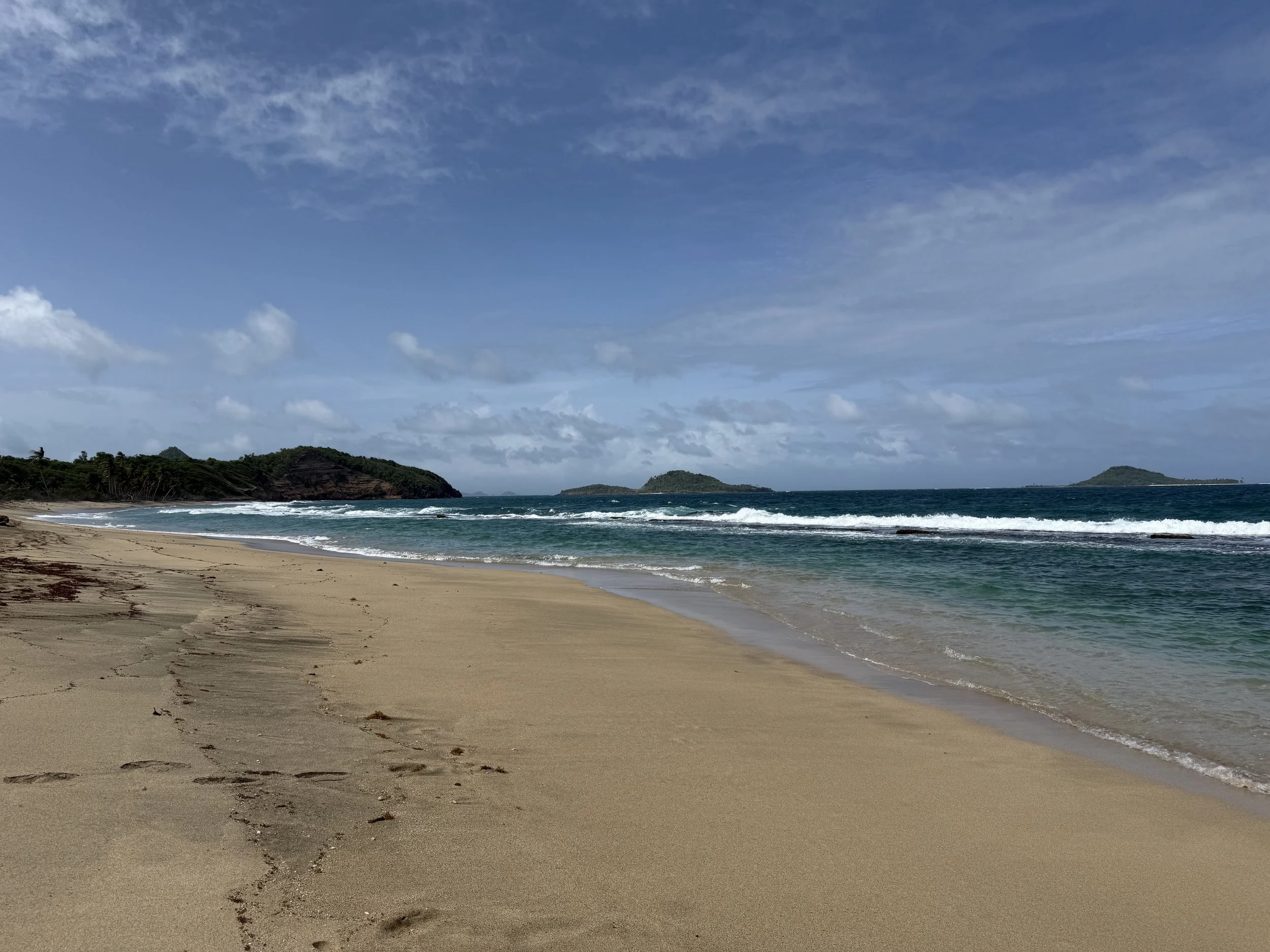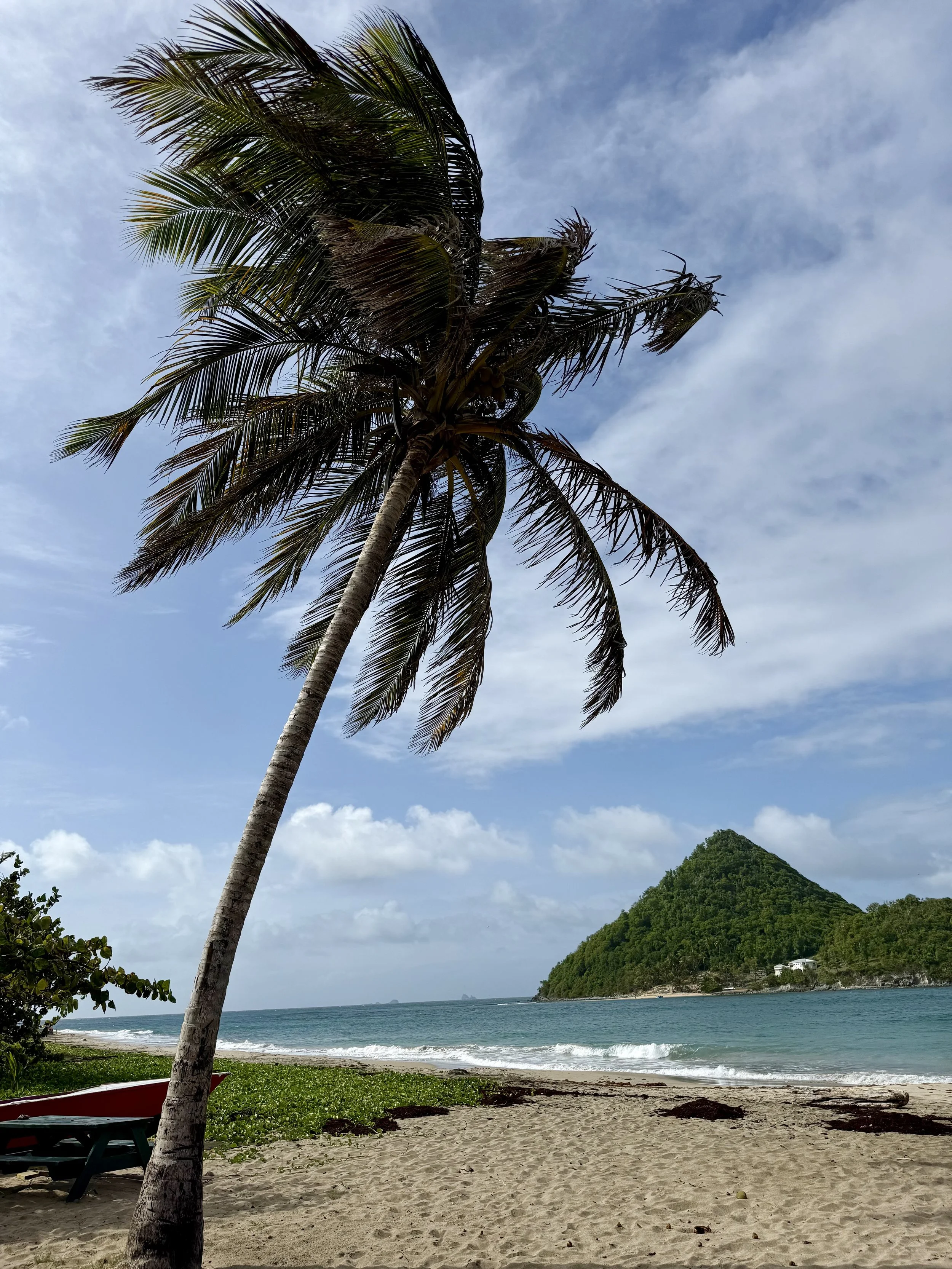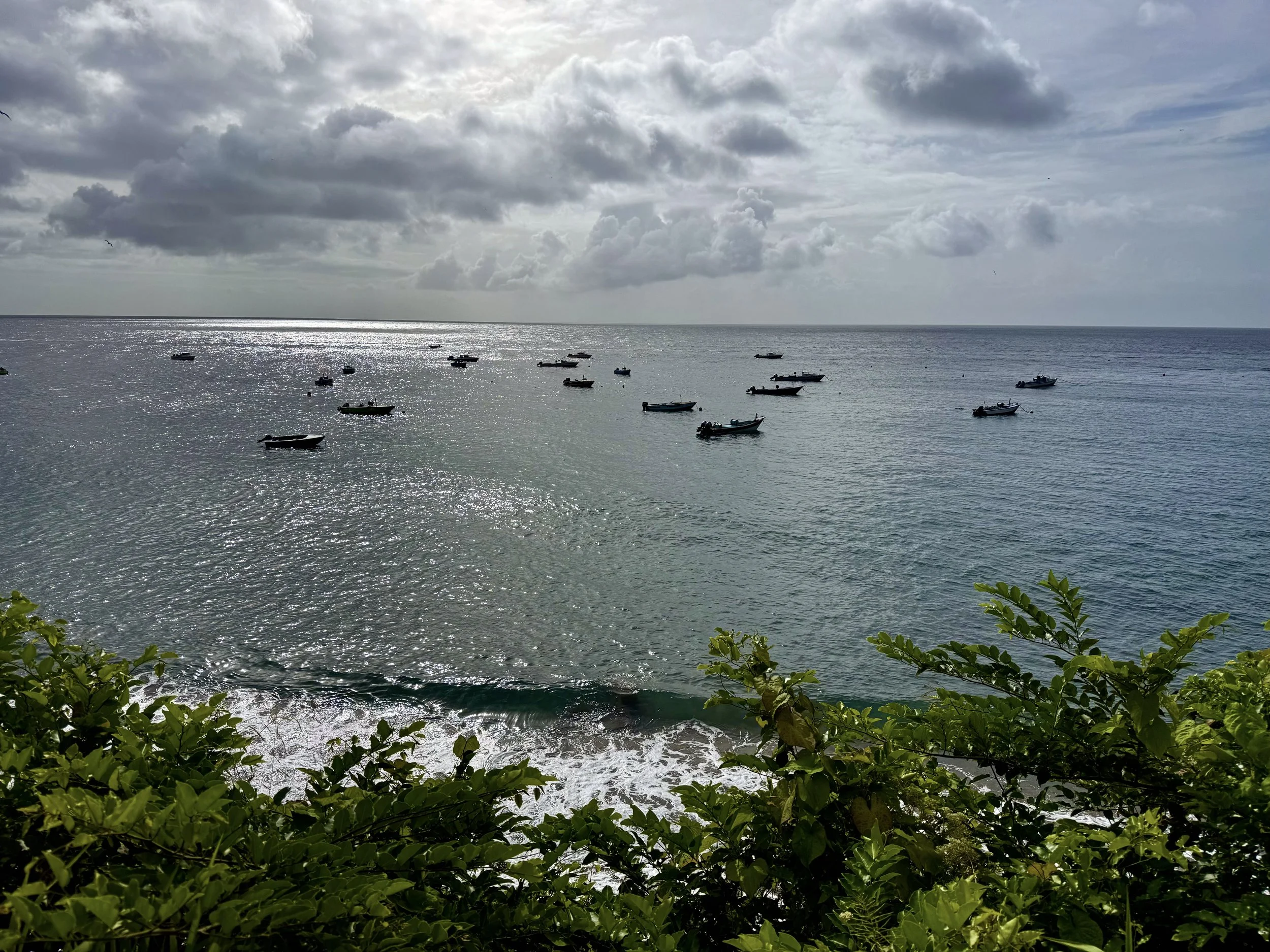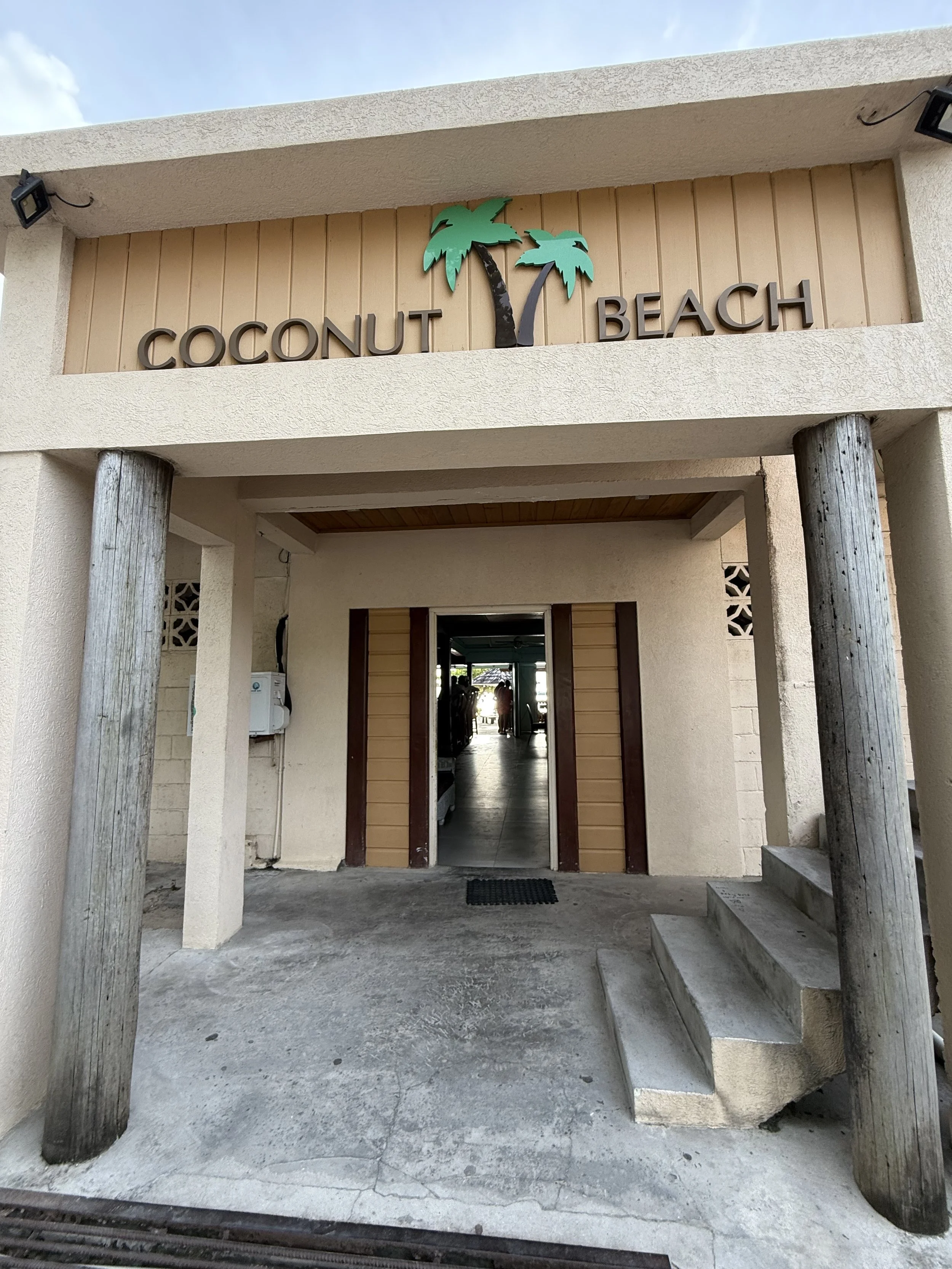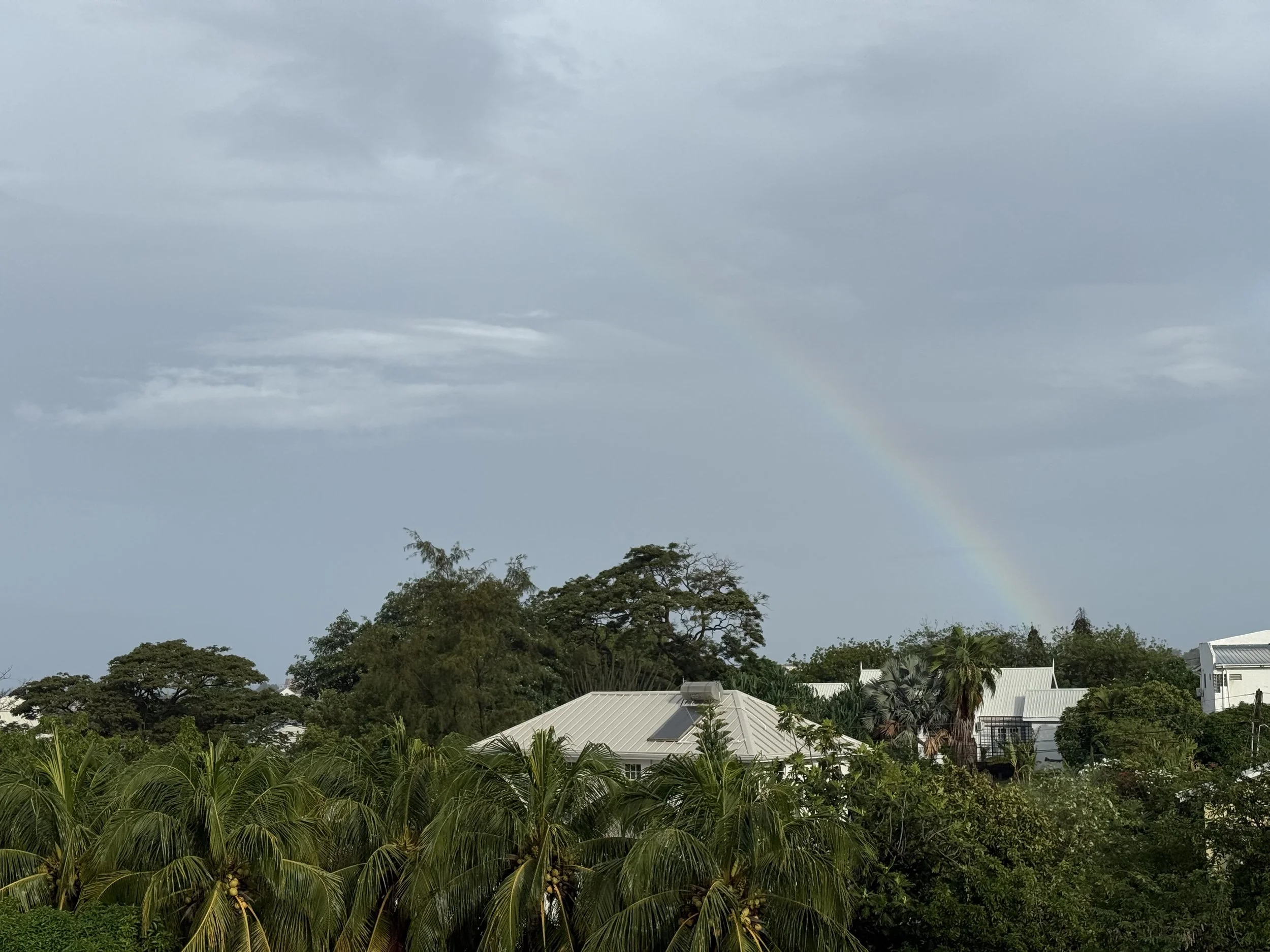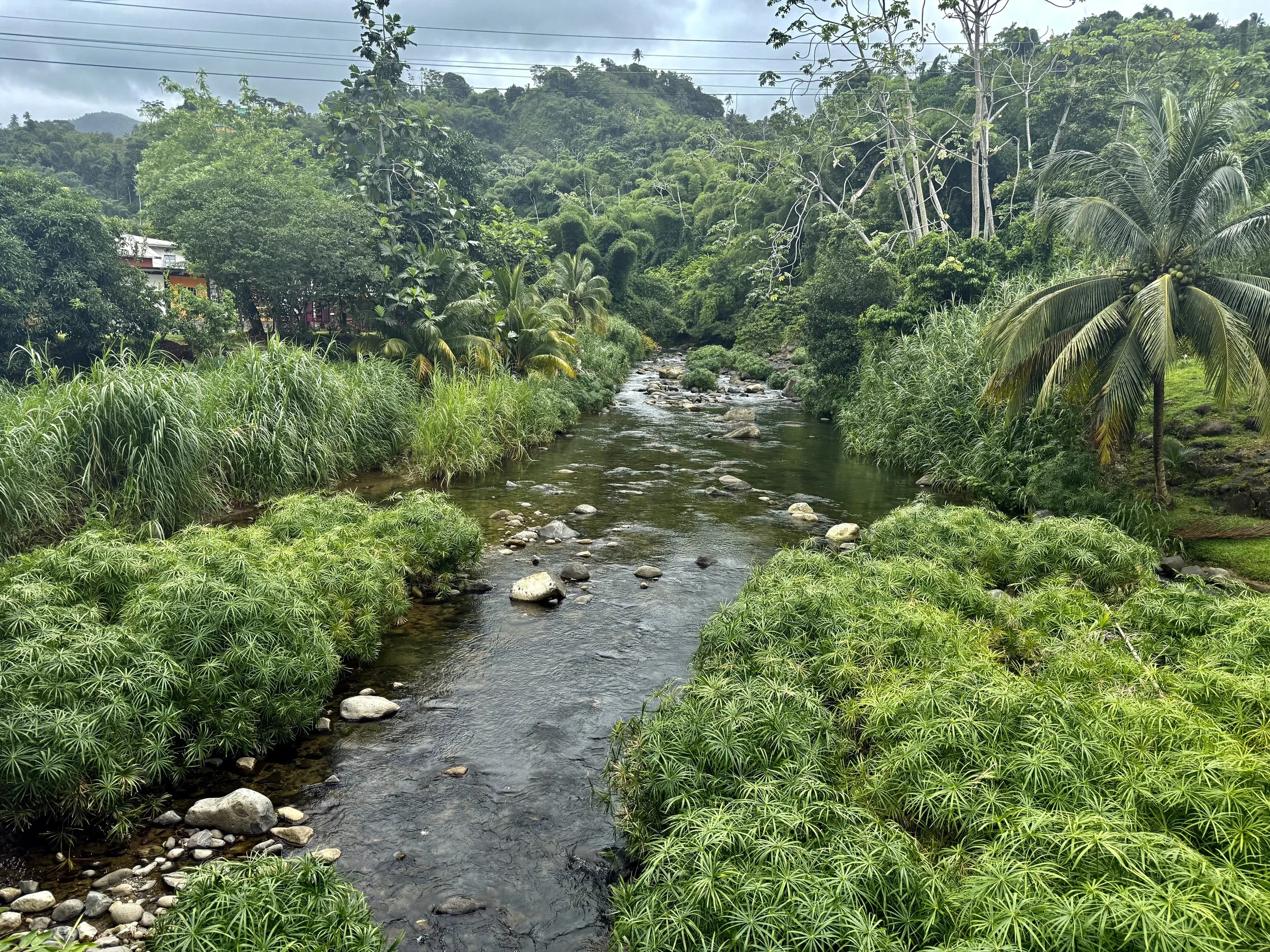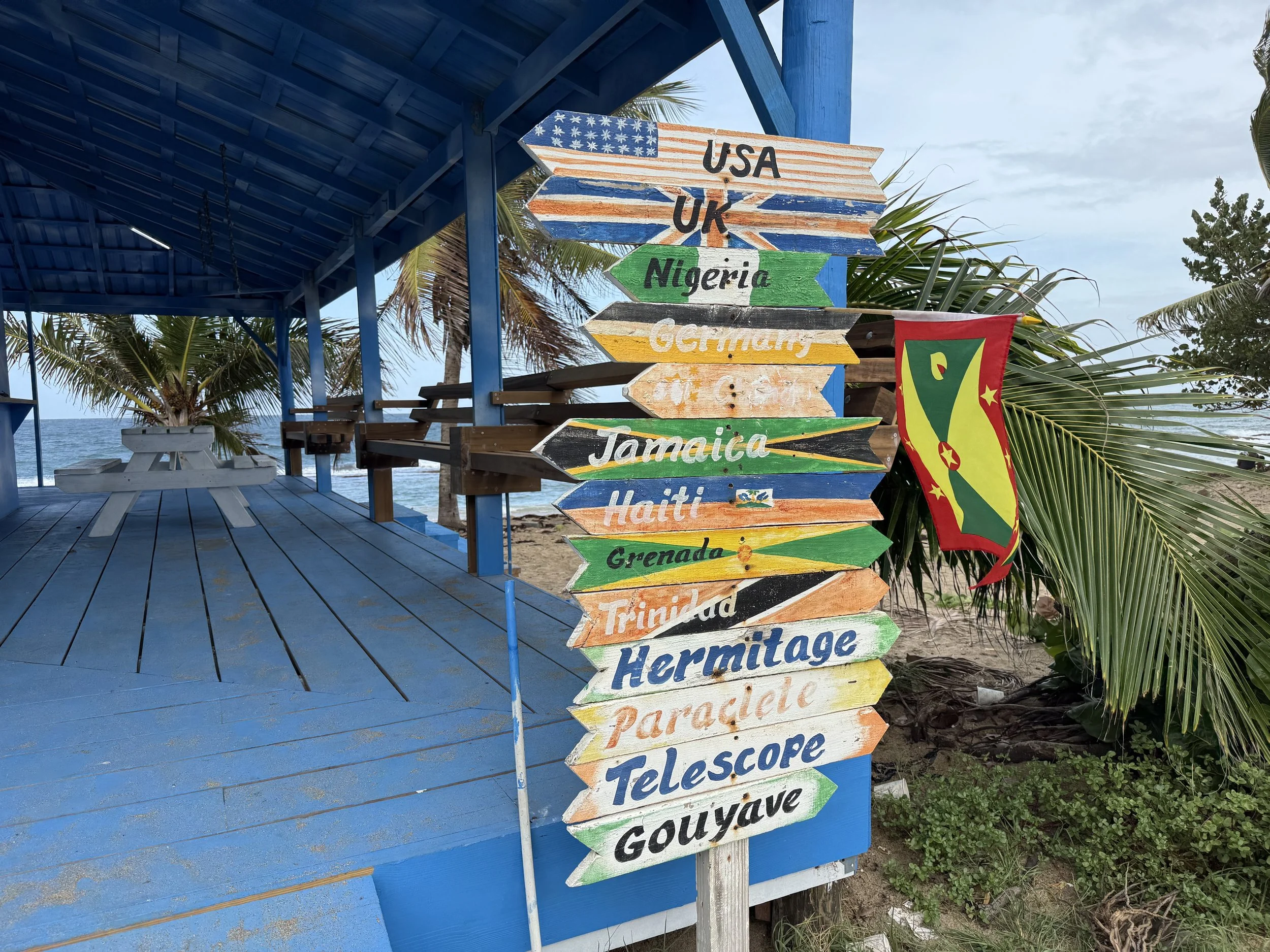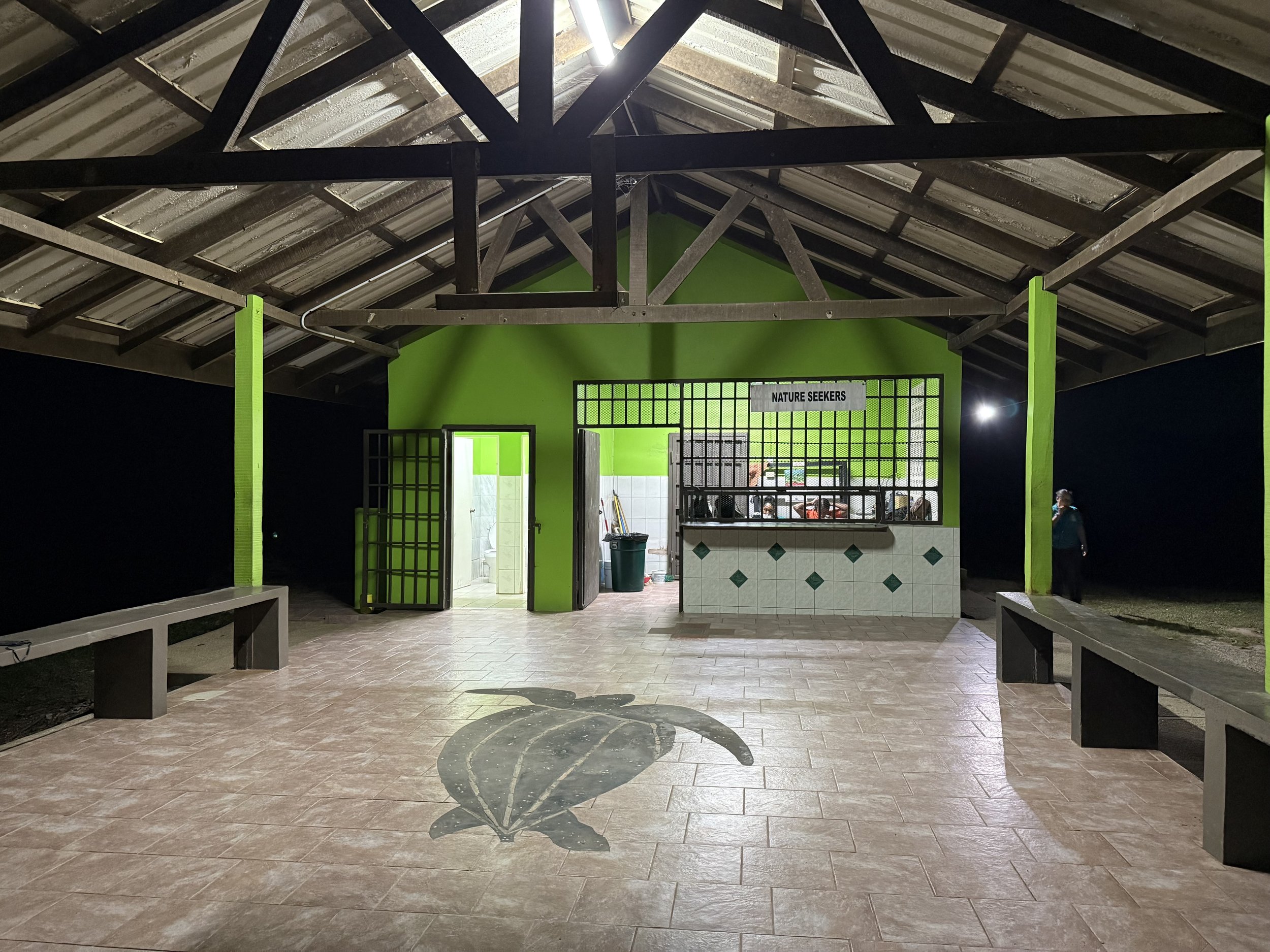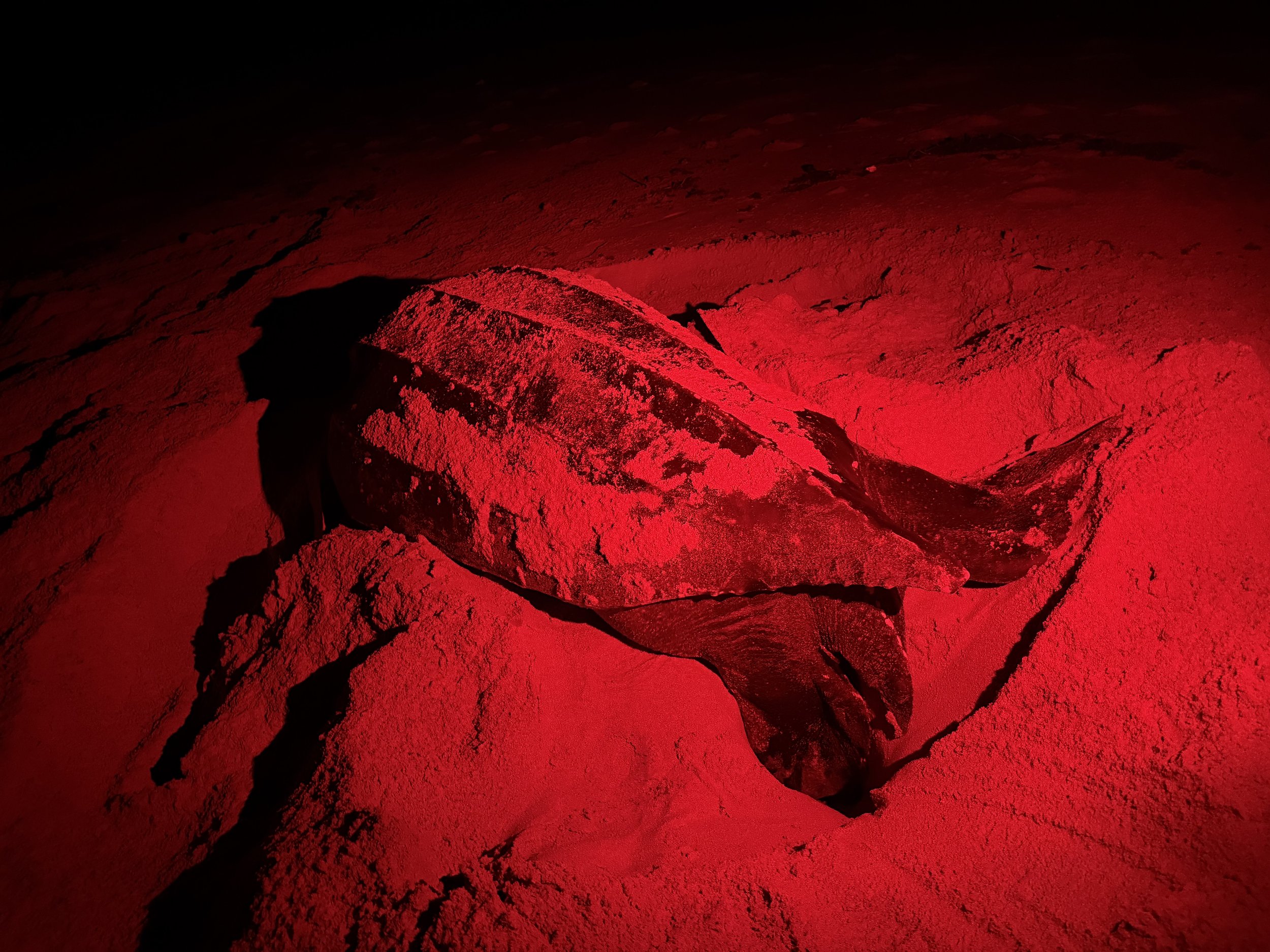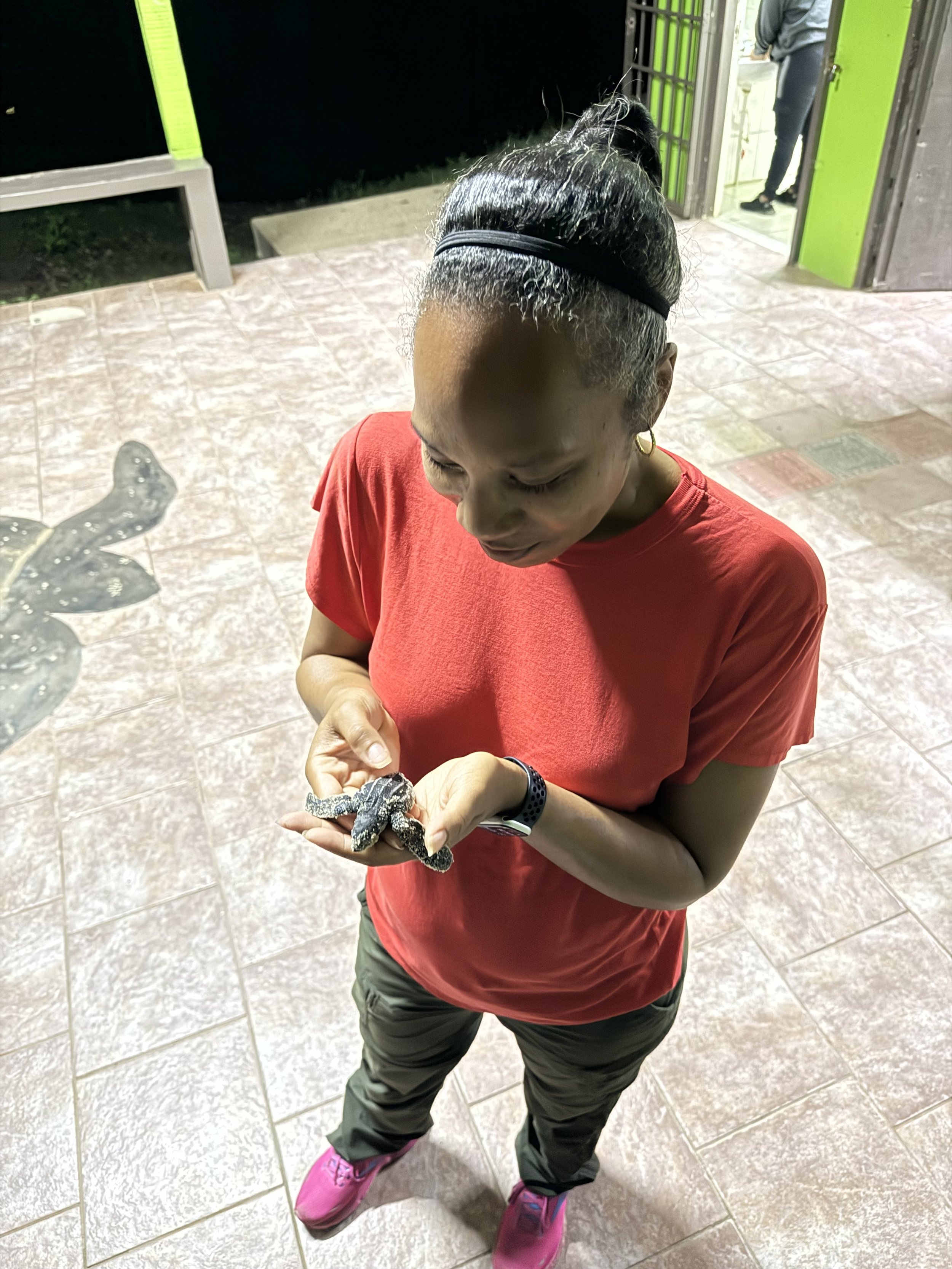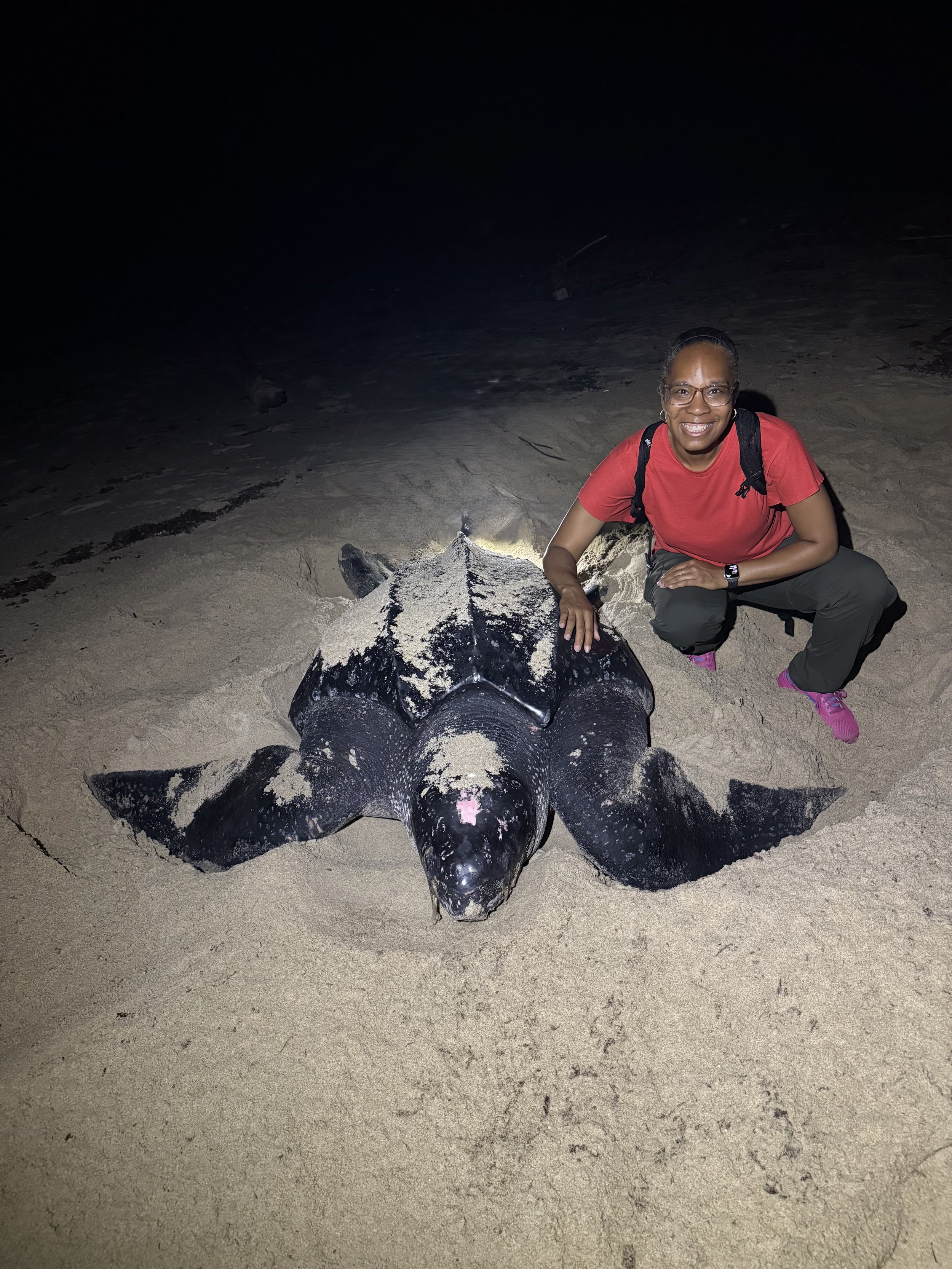2 Days in Grenada: Spice Markets, Scenic Drives, and Seaside Sunsets
I flew into Maurice Bishop International Airport (GND) from Trinidad and caught a taxi straight to Mandela Court Hotel in Lance aux Épines. It’s a quiet, mostly residential area—close enough to beaches and restaurants without being caught in the crowds. The hotel itself is elegant and understated, with Mediterranean-style architecture, soft pastel walls, and tall windows that let in plenty of light. My suite had a full kitchen and a comfortable living space, which made it feel more like a short-term apartment than a traditional hotel room. The central atrium is airy and bright, with polished tile floors, modern furniture, and a dramatic staircase that winds up both sides of the lobby. Out back, there’s a small pool surrounded by lounge chairs, perfect for cooling off between outings. It’s a relaxed, low-key spot—ideal if you want space and comfort without the resort bustle.
Day 1: Island Loop and Spice Lessons
That afternoon, I set out on a private tour around Grenada. We began at the bustling Saturday market in St. George’s, where vendors packed the sidewalks and traffic crawled through the crowd. A light rain had just started, giving the pavement a slick sheen as people moved at an unhurried pace under umbrellas. The stalls were filled with fresh produce, local spices, live chickens, household goods, and the occasional rack of knockoff sneakers. The air smelled faintly of herbs and something frying nearby. It was a grounded, everyday kind of busy—a window into real island life.
Our next stop was a neighborhood spice shop. Grenada is known as “The Spice Island” and is one of the world’s top producers of nutmeg, cinnamon, and cloves. I got a quick demo, sampled raw spices, talked with the shopkeepers, and picked up a few things to bring home. It’s also where I learned about nutmeg syrup, which is used in local desserts and drinks.
From there, we passed a rainbow eucalyptus tree, then headed into the island’s mountainous interior. We stopped at Morne Qua Qua, the highest drivable point on the island, located near Grand Etang National Park. The lookout offers panoramic views of the rainforest and, on clear days, a glimpse of the coastline. I also walked a short trail out to Grand Etang’s crater lake, formed in the caldera of an extinct volcano. A lone mona monkey lingered near the trail—most likely hoping for snacks, though visitors are advised not to feed them.
We made a brief stop at Annandale Falls, a popular spot where visitors often swim or watch local cliff divers leap from the rocks. I didn’t do either—just took a short walk around, looked at the falls, and continued on.
I made a quick stop at Fort Frederick, perched on Richmond Hill just outside St. George’s. Built by the French in the 1700s, it’s one of the best-preserved forts on the island—and one of the few where the cannons face inland instead of out to sea, thanks to a history of surprise land attacks. The fort itself is relatively small, but the panoramic views are what make it worth the visit. From the top, you can see Grand Anse Beach on one side, the Carenage on the other, and the lush hills rolling inland. There’s no real signage to guide you, but admission is free, and you can wander around on your own. It’s a quiet spot, not crowded when I went, with a steady breeze and plenty of photo ops. If you’re driving, it’s a quick stop that doesn’t take more than 30–45 minutes unless you want to linger.
Later, I made a quick pass through Grand Anse Beach—a postcard-famous stretch of soft sand and turquoise water—but I didn’t linger. It was mid-afternoon and hot. I ended the day at La Plywood, a casual beachfront bar built from scrap wood, where I sat inside and watched the sun go down through the open walls. We listened to live music and ate fries and fish tacos. After sunset, the lights came on—and the bugs seemed to materialize from nowhere. The place was suddenly buzzing with small flying insects I couldn’t identify. To escape them, I took a walk along the beach and watched the stars come out as the waves slapped the coastline.
Day 2: Beach Loops and Back Roads
I started the morning with a walk to West Indies Beer Company, a laid-back brewpub that doubles as a community hangout. On Sunday mornings, it draws a steady mix of locals and expats—some there for brunch, others catching up over a drink. Formula 1 was playing on the TVs, and the bar was already half full by the time I arrived. I ordered an egg and cheese sandwich, which took its time coming out. No rush, though—the pace matched the atmosphere. Some folks were chatting at the bar, others sat in pairs or small groups at the outdoor tables. After eating, I strolled down to Lance aux Épines Beach, which was quiet and practically empty.
Later, I drove north for a hike up to the Welcome Stone—a steep, short climb that rewards you with wide, sweeping views over Levera National Park and the island’s northeastern coast. Definitely worth the stop.
Lunch was at Bathway Beach—a plate of chicken wings, fries, and an Angostura Chill (lemon-lime with bitters). There’s a public restroom, but it costs $1 EC to use, so bring change. Afterward, I walked along Levera Beach, a more rugged, undeveloped stretch of coast—less polished than Grand Anse but with plenty of natural charm.
One thing I liked about the beaches in Grenada is that they’re mostly populated by local people. Whether it was the quiet stretch at Lance aux Épines or the more open sand at Bathway, they came across as uncommercial and familiar. Most of the top destinations here are beaches, and you can tell they’re part of everyday life, not just set up for tourists.
The drive back followed the winding western coastal road, cutting through quiet fishing villages tucked between the hills and the sea. At one point, we pulled over to take a photo of brightly painted boats bobbing in the water. Nearby, a group of kids was playing along a stretch of black sand beach—tumbling in the sand and tossing each other into the air to land backflips. I smiled at its innocence and simplicity.
Dinner was at Coconut Beach Restaurant, right on the water—fresh seafood, relaxed atmosphere. I ate stewed chicken while watching people play in the water and a few late-afternoon speed boaters getting a last lap in. As the sun began to sink below the horizon, I headed back to the hotel. The next day, I’d be heading home.
Day 3: Rain, Rainbows, and Heading Out
I woke to the sound of wind and rain tapping against the windows—a steady downpour that lasted about an hour. When it finally let up, I opened the window and spotted a rainbow stretching over the trees. The rest of the morning was slow and quiet. I stayed in, packed up, and relaxed until it was time to check out. Then I called a cab to the airport—and just like that, my time in Grenada came to an end.
Quick Travel Notes:
• Currency: Eastern Caribbean Dollar (XCD), but USD is widely accepted. Expect change in EC.
• Driving: Left side. Roads are paved but narrow and winding.
• Taxis: No meters—fares are negotiated upfront. My ride from the airport to Lance aux Épines was $20 USD.
• Tours: A private full-day island tour cost about $100 USD, which included pickup, fuel, and stops anywhere I wanted.
• Tap Water: Safe to drink.
• Island Size: About 134 square miles. You can drive across in under two hours.
• Language: English.
• Electricity: 230V, UK-style plugs.
• Weather: Hot and humid year-round; rainy season runs June to November.
Other Places to Check Out (If You Have Time):
• Belmont Estate – A working cocoa estate with farm tours and local food
• River Antoine Rum Distillery – Home to Grenada’s strong overproof rum, made using a waterwheel
• Underwater Sculpture Park – Best accessed via snorkel or dive trip from Grand Anse or Molinière Bay
• La Sagesse Beach – Quiet, scenic beach with fewer tourists
• Gouyave Fish Friday – A local street party with fresh seafood and music (check if it’s running)
A Night with the Leatherbacks in Trinidad
Female Leatherback Sea Turtle
I traveled to Trinidad with one goal: to see the leatherback sea turtles. I’d been dreaming about witnessing these sentinel giants in person for years, and when I found out that Trinidad’s nesting season runs from March to August, I didn’t hesitate—I booked the trip.
I arrived in late June, which, to be honest, isn’t the ideal time. If you’re planning a visit specifically to see the turtles, April and May are peak nesting months. Still, I crossed my fingers and hoped for the best.
The day after I landed, I headed out on a private tour arranged by Island Experiences. My guide and driver, Kahlil, picked me up at 5:30 PM, and we made our way to the east coast of the island. Our destination: Matura Beach.
The drive took about an hour and a half, winding through countryside, small towns, and villages as the sun slipped behind the hills. Somewhere along the way, we stopped for snacks—fuel for the night ahead. Kahlil, who was both friendly and incredibly knowledgeable, explained what to expect and warned that some of the roads might be a little rough.
Nature Seekers Pavilion
We arrived at the Nature Seekers facility just as the night shift staff was settling in. While the team got ready to patrol the beach for turtle activity, I waited at the pavilion with Kahlil and two staff members. It took a couple of hours, but then came the call over the radio: a leatherback had emerged from the ocean. She was a bit of a walk away, though—maybe 15 minutes through a wooded area and across the sand.
I was ready.
We hiked through the darkness using only red light to guide our steps. And then, there she was—massive, glistening, and ancient-looking. A leatherback sea turtle in all her glory. Her trail in the sand was the first sign, but seeing her up close was something else entirely.
My guides on the beach, Kenisha and Thiara, were phenomenal. Their passion for their work was palpable. As the turtle began her nesting process, they explained every step: why we use red light until she begins laying (she enters a trance-like state and becomes less sensitive to disturbance), why her eyes appeared teary (a natural salt-cleansing process), and how they collect data for conservation.
Sea Turtle laying eggs
Here’s what I learned about nesting:
The female uses her powerful back flippers to dig a deep, flask-shaped hole in the sand. Once the nest is ready, she lays her eggs—some viable, some not. The non-viable eggs act as a cushion, protecting the others as she deposits as many as 100 eggs into the chamber. It’s an incredibly labor-intensive process that can take over an hour. Once she’s finished, she carefully covers the nest with sand, disguising it from predators.
Once the team completed their tagging and data collection, we stepped back and let her make her way to the water. I watched as she slowly moved toward the surf, pausing between waves until the ocean finally swept over her.
I thought that was the end of the night, but then came a surprise: I got to hold a leatherback hatchling.
Yes, you read that right.
I was already riding a high from seeing the nesting female, but this sent me over the moon. The baby turtle was tiny—small enough to fit in my palm. It was wild to hold something so small that would one day grow to be five or six feet long. I carried it gently to the shoreline in a small bucket lined with beach sand. It’s important that hatchlings crawl on the beach before entering the ocean, as that’s how they imprint on the location.
The little one got a bit turned around at first, but with some patient red-light guiding, it found its way to the water. The waves came in and—just like that—it was gone.
I couldn’t stop smiling.
Overall experience: 10 out of 10. Would do again!
About Nature Seekers & How You Can Help
This incredible experience wouldn’t have been possible without the work of Nature Seekers, a local conservation group based in Matura, Trinidad. Since 1990, they’ve been protecting endangered leatherback sea turtles and educating the public about the importance of preserving these ancient creatures.
Their team—made up of passionate guides, researchers, and community members—monitors nesting sites, tags and tracks turtles, and protects eggs from poachers and predators. They also engage in reforestation, environmental education, and beach clean-ups. It’s a true community-driven conservation effort, and they’ve helped turn Matura into one of the safest nesting beaches for leatherbacks in the world.
Want to support their mission? Here’s how you can help:
• 🐢 Donate directly via their website: natureseekers.org
• 🧑🏽🤝🧑🏽 Volunteer with their turtle conservation or reforestation programs
• 📢 Spread the word by sharing their work or planning a visit of your own
Whether you’re traveling to Trinidad or just want to make a difference from afar, every bit of support helps keep these sentinel giants coming back year after year. Visit their website at natureseekers.org
Welcome to Punta Cana, Dominican Republic
Punta Cana, on the easternmost tip of the Dominican Republic, is a tropical paradise with white-sand beaches, clear waters, and vibrant resorts. It’s a popular tourist spot with lots of activities, from relaxing on the beach to exploring nature like the nearby Indigenous Eyes Ecological Park. Punta Cana is also known for its all-inclusive resorts, golf courses, and water sports like snorkeling, scuba diving, and zip-lining. With its warm, sunny weather year-round and attractions for families and couples, Punta Cana is one of the Caribbean’s most sought-after vacation spots. Whether you’re looking for adventure or just want to relax in paradise, Punta Cana has something for everyone.
How I got there:
I flew a direct flight from Chicago’s O’Hare Airport to Punta Cana International Airport. It was a beautiful, warm, and sunny day when we arrived.
Upon landing, we took a shuttle from the plane to the main terminal to clear customs.
Once customs was done, I headed to the transportation counter where I caught the shuttle to my resort. I was a bit lost for a moment because the shuttle staging area was a bit chaotic. I eventually found my shuttle and we were off. The ride took about 30 minutes.
Where I stayed
I stayed at the Riu Hotel Bávaro, which is an all-inclusive resort in the Bávaro region of Punta Cana. It’s part of the famous Riu Resort complex. This beachfront resort has offers a plethora of amenities to cater to every need. The resort has spacious rooms, multiple restaurants, bars, and a variety of entertainment options. The Riu Hotel Bávaro is a fantastic place to stay, with a huge swimming pool, a spa, a fitness center, and tons of water sports. Whether you’re looking for a romantic getaway, a family vacation, or an exciting adventure, this resort has something for everyone.
In addition to its on-site amenities, the Resort Complex had several common areas that everyone can enjoy. There’s a thrilling water park and a lively party area with all sorts of themed parties.
Check out www.riu.com for more info.
Currency
The official currency is the Dominican Peso, but many places in tourist areas, especially resorts, shops, and restaurants, are happy to take US dollars. Just remember that the exchange rate might not always be the best, and you’ll usually get change in Dominican Pesos. It’s always a good idea to check the exchange rates and carry some local currency when you’re not using dollars.
Languages
The main language is Spanish, but in tourist areas, you’ll find a lot of English speakers. Most hotel and resort staff also speak English.
Getting Around
Taxis are relatively easy to find, especially in big cities and tourist spots. They don’t typically have meters, so it’s best to agree on a fare before you start your ride.
Motoconchos (Motorcycle Taxis): These are a fun and cheap way to get around short distances. They’re like motorcycle taxis, and they’re great for quick trips. Just be careful when you’re riding them.
Public Buses: There are affordable public buses that connect major cities and towns. They’re run by different companies, and they have different names like “guaguas.” These are minivans or small buses that follow set routes.
Private Car Rentals: Renting a car is a great way to explore the island at your own pace. Be careful about renting from non reputable establishments. Repairs on those vehicles can be questionable.
Guagua (Minibus): These are shared minibuses that travel along fixed routes and are a popular way for locals to get around. They’re super affordable and a great way to see the island.
Tourist Shuttles: Many resorts and hotels provide shuttle services for tourists, especially for airport transfers and excursions.
Bicycles and Walking: In some areas, cycling or walking can be a fun way to explore, especially in beach towns or smaller cities.

